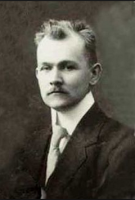










Bernhard Woldemar Schmidt, who lived between(1879 – 1935) in Hamburg, Germany.He was a German optician. In 1930 he invented the Schmidt telescope which corrected for the optical errors of spherical aberration, coma, and astigmatism, making possible for the first time the construction of very large, wide-angled reflective cameras of short exposure time for astronomical research.
Early Life
Schmidt was the son of Carl Constantin and Marie Helene Christine (nee Rosen) Schmidt. He was born and grew up on the island of Naissaar (German: Nargen), off the coast of Tallinn (Reval), Estonia, then part of the Russian Empire. The inhabitants of this island, mainly Estonian Swedes, generally spoke Swedish or Estonian, but the Schmidt family also spoke German. Bernhard was the oldest of six children, three boys (one of whom died in infancy) and three girls.
Naissaar was a small, rural island whose population mainly supported themselves through fishing and piloting ships into the port of Reval. With his younger brother August Fredrik, Bernhard Schmidt engaged in many childhood adventures on the island. He was an extremely inquisitive, inventive, and imaginative young person and adult. For example, when young he built his own camera from a purchased lens and old concertina bellows and succeeded in photographing his local surroundings and various family members, and even sold some of his photos. He also became fascinated with the night sky and constellations.
One misadventure proved tragic and marked Schmidt for the rest of his life. When he was 15 years old, he experimented with gunpowder. He packed an iron pipe with a charge, but through a mistake with the fuse the pipe exploded, and he lost the thumb and index finger of his right hand. Despite his mother's attempts to clean and bandage the wounds, surgeons in Tallinn later amputated the whole hand. This event appears to have deepened his reserve and introspection, qualities well noted by his contemporaries in later life.
Invention of Schmidt Camera
Astronomers had long wished for a way to photograph large swathes of the sky quickly for the purpose of surveying the visible contents of the universe and seeing large-scale structures. Ordinary telescopes up till Schmidt's time showed narrow fields of view, typically measuring 1 or 2 degrees in diameter. Surveying the whole sky with such telescopes required an enormous investment of time and resources over years and (because of the narrow views) tended to miss large structures. It was possible to see large swathes with small camera lenses, but then faint (and hence far away) objects would remain invisible. What was needed was large aperture cameras possessing wide fields of good imaging properties ("definition"), and fast focal ratios to decrease exposure times.
Unfortunately, the only large aperture wide-field telescopes before Schmidt were ordinary reflecting telescopes of short focal ratio (about f/3), and these presented images which while sharp at the middle of their fields of view, quickly lost their definition away from the field center. Star images became bloated and comet-shaped, with the head of the "comet" pointing to the middle of the photographic field. This bloating results mainly from the optical aberrations (i.e. errors) called "coma" and "astigmatism". Before Schmidt it was impossible to build a large, fast reflector telescope which was not plagued by these errors.
Schmidt was well-aware of this and had been pondering possible solutions during the late 1920s. According to Baade, he had abandoned at least one solution already, when finally he hit upon his ultimate design, which involved a novel, indeed bold departure from traditional optical designs. Schmidt realized that by employing a large spherically shaped mirror (instead of the normal paraboloidal mirror of a reflector telescope) and a smaller apertured diaphragm placed at the center of curvature of the mirror, he could at a stroke eliminate coma and astigmatism. He would be left, however, with spherical aberration which is just as damaging to image sharpness.
His boldness lies in realizing that he could eliminate the spherical aberration by placing a thin, very weakly curved aspheric lens (now called the "Schmidt corrector plate") at the same center of curvature as the apertured diaphragm. This aspheric lens has a complex curve that is convex near its middle and concave near its periphery that creates the opposite spherical aberration of the spherical mirror it is paired with, canceling out the mirror's spherical aberration. In this way, very neatly and simply he could construct a large camera of f/1.75 or even faster, that would give sharp images across a field more than 15 degrees in diameter, making it possible to image large swathes of sky with short exposures (on the order of a few minutes versus an hour or more with a conventional reflector). His first camera had an aperture of about 360mm or 14.5" in diameter, and a focal ratio of f/1.75. It is now housed in a museum at the Hamburg Observatory. Schmidt's combining of diverse optical elements (a special mirror, a diaphragm at a particular location, and a "correction plate") into a simple catadioptric system, based on reasoning from first principles, was epoch making. In particular, the "correction plate" was like nothing ever seen before in telescope design. After Schmidt a flood of new catadioptric designs appeared in the subsequent decades.